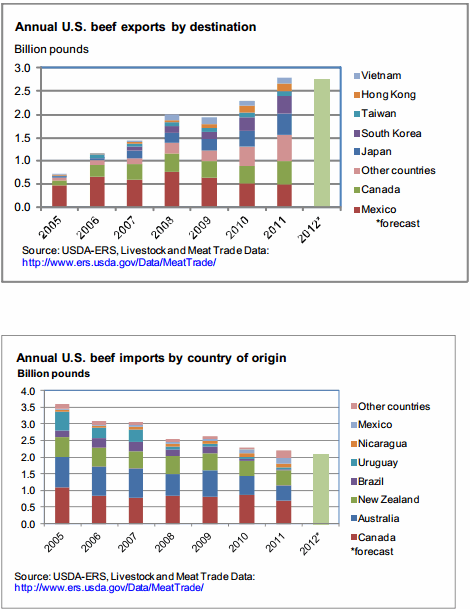For much of 2011, the U.S. beef imports can be summarized as constrained by Australia and New Zealand’s efforts to rebuild their cattle herds and, subsequently, lower quantities of beef available for export from Oceania; a relatively weak U.S. dollar, making prices of foreign imported products higher; and continuing strong demand for beef in global markets. Total 2011 U.S. beef imports were 10 percent lower than year-earlier levels, making the United States a net exporter of beef in 2011 by 32 million pounds. Canada was the top supplier of beef to the United States on a quantity basis in 2011, providing one-third of total U.S. beef imports. Imports of Canadian beef, however, were 20 percent lower year-over-year. Australia and New Zealand were the second and third largest exporters of beef to the United States, although nearly equal quantities were imported from these countries; approximately 22 percent of total U.S. beef imports were imported from each country. Year-over-year imports from Australia were 20 percent below a year ago, compared with 3 percent lower for New Zealand. Imports from Mexico and Central America (Nicaragua, Costa Rica, and Honduras) were higher year-overyear, by 44 and 27 percent, respectively, as these countries captured market share from Australia and New Zealand. Beef imports from Brazil, Argentina, and Uruguay remain at considerably lower levels compared with previous years. Primarily, limited supply has hampered beef exports for Uruguay and Argentina; thus, these countries have generally reduced shipments to all markets, including the United States. Brazilian-U.S. beef exports (processed beef only) are expected to continued to recover, as they have been since trade resumed mid-year 2011.
Beef imports for 2012 are forecast at 2.09 billion pounds, or 2 percent higher than 2011. While beef production, and subsequently exports from Australia and New Zealand, are expected to increase this year, growth will be limited by producers retaining stock for breeding purposes. Weather and forage conditions in Australia will be among the primary determinants for cattle slaughter levels and thus for exportable supply. Export returns were lowered in 2011 by the strength of the

Australian dollar, and the exchange rate will also be a factor in determining to which countries will be more competitive in bidding for product in 2012. Given the herd rebuilding efforts that are already underway in Canada, exports from Canada will be also be constrained, but there is still expected to be significant Canadian incentive to export because of U.S. demand for processing beef. With the apparent supply constraints among the major U.S. beef trading partners, Mexico and Central American countries should continue to pick up some of this slack.
Source: USDA.